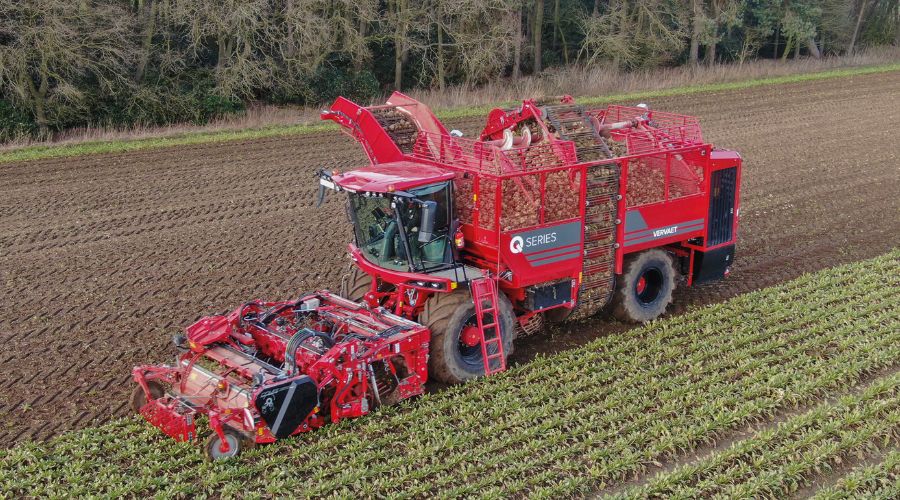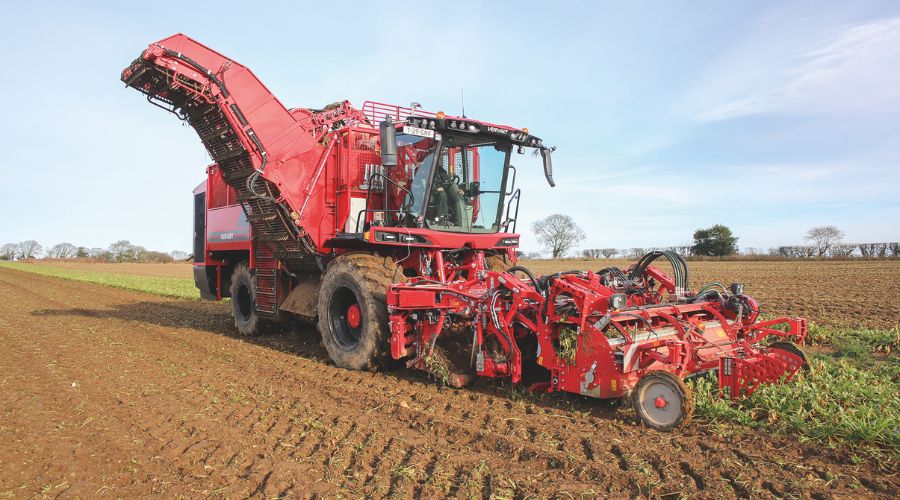Vervaet beet harvesters get significant upgrades
27th March 2025
David Williams enjoyed an early test-drive of the popular upgraded self-propelled beet harvesters.

Imported by Norfolk-based J Riley Beet Harvesters, Vervaet models account for the lion’s share of the 15–20 new machine UK beet harvester market. The Dutch manufacturer offers four-wheel 18 and 21t, and six-wheel 21t models, but the Q616 with four wheels and an 18t capacity hopper is by far the most popular here, being well matched with 20t trailers when unloading on the move.
“Vervaet beet harvesters are known for their high residual values, which is an important consideration for farmers and contractors investing in this sort of machinery,” explained managing director, Matt Carse. “At J Riley, we pride ourselves in the back-up we offer our customers, and that extends just as much to older models dating back to the 1990s as for the latest machines.”
Most popular model updated
The most visible upgrades for the 2025/26 harvesting season are refreshed livery, and a completely new cab. Vervaet’s traditional red continues to dominate, but there is also metallic grey, and the wheels are black – replacing the previous creamy white. As before, the cab is from Claas.
The updated beet harvester has the latest X11 version from the Trion combine with more space, narrower windscreen pillars, a larger door and a bigger glass area for increased visibility. Hidden from view is a completely new electric system, new shock protection for the lifting shares and significantly quicker hopper emptying.
Improved topping and lifting
Vervaet’s Gen 3 lifter and topper are now standard, incorporating new potentiometers bringing extra reliability and accuracy to the auto-steer system. Complementing the automatic steering, improved automatic machine levelling to 8 degrees left and right makes it easier for the guide wheels to maintain a central position between the rows for optimum row following.
A combi-topper with an integral mulcher offers users the choice of discharging tops out of the side or chopping and dropping them between the beet rows.
One of the main topper upgrades is hydraulic stone protection for the lifting shares. Each pair of shares is held in its working position by a pressurised hydraulic ram. If the lifting assemblies strike large stones or other solid objects, then they can move back and upwards avoiding damage.
As soon as the obstruction has been passed then the shares automatically return to the working position. Matt commented that although impact damage to shares is rare, the protection system provides additional benefits including reduced wear and tear.
This is because the hydraulic rams permit a small amount of controlled movement when operating on hard, dry or stony ground, reducing chipping and damage to the tungsten leading edges and extending the working life.
The new header also benefits from a streamlined hydraulic circuit with reduced oil flow resistance, reducing operating temperature and saving fuel.
Extra reliability with more features
The new full Can-bus electrical circuit increases reliability, while also allowing new features to improve the operator experience. This includes the ability to select almost any combination of individual work and road lights to suit any situation. The camera monitoring system is also more versatile with extra automation, and a 360-degree ‘overhead view’ is now standard.
Hopper emptying management is new. Previously hydraulic pressure sensors monitored the unloading elevator working load and the main bunker floor chain switched on and off as required to supply more beet. This worked well, but the basic on/off action meant the unloading rate varied.
The new system is proportionate, simply adjusting the floor chain speed to maintain a constant supply to the elevator. Keeping it full without running the bed chain excessively saves fuel while reducing wear and tear, and it also reduces damage to the beet.
Although the unloading elevator is the same as before, the new proportional feed system means it unloads some 30% faster. During the Farmers Guide test drive, the 21t tank of the Dutch demonstration machine emptied in approximately 56 seconds.

More space, extra visibility
The latest Claas cab is more spacious, but it also feels much larger due to the narrower corner pillars. Vents previously within the pillars are now in the roof in two rows – one at the front against the windscreen that keeps the screen clear and warms the operator’s feet, while a second row nearer the driver allows a more targeted flow of warm or cold air.
The main control terminal features new navigation – making it quicker and easier to identify and select menus and settings for any aspect of operation. As before, all the main functions are operated through the main joystick, but the new electrical system gives a more precise feel.
Vervaet has also improved maintenance access. Diesel and AdBlue fillers are side by side and easily reached through the rear door.
First test drive
The Farmers Guide test drive was on a Norfolk farm in early February. The demonstration machine spent harvest in Holland and Germany before arriving in the UK for the final few weeks of harvest. Although in all other respects it was like the 18t Q616, the prototype was a Q621 version with a 21t hopper.
The Vervaet is very easy to drive. Controls are intuitive and the main joystick provides ultra-precise travel speed control. The view from the seat is excellent, including of the lifters and the cleaning table. The test machine was set up so that when reverse is selected, the in-cab screen display switches to show the view to the rear.
The new, standard, 360-degree ‘overhead view’ was a big help when manoeuvring in tight field corners. The DAF engine at the rear operates at a low, 1,200rpm for most of the time and there is little noise from the hydraulic drives. The demonstration machine had the standard seat which was comfortable, but buyers can also upgrade to a seat with electric heating and ventilation.
Recent Vervaet convert
Farmers Guide visited a farming and contracting operation which recently changed from a competitor brand machine to a second-hand Vervaet from J Riley.
Trading as CJC Lee and operating from a base at Saxthorpe in north Norfolk, the business sold its previous tracked harvester and bought the Q616 last year. “I really like it,” commented operator, Ben Baker. “It’s simple and easy to work on and if issues occur then we can often fix them ourselves, with advice over the phone from the knowledgeable J Riley team if needed.
“The dealer holds huge stocks of parts, so we are never stopped for long. From Matt Carse to the parts counter and workshop engineers, it’s brilliant service.”
When Farmers Guide visited in early February, the Q616 had almost completed its third harvest, and recorded approximately 3,300 engine working hours. “We knew the reputation of Vervaet and J Riley, so when our previous harvester was due for updating and there wasn’t a modern equivalent, then moving to Vervaet was the obvious choice.
“I worried moving from a tracked machine to wheels and thought we might struggle in the wet, but these large tyres perform well and when conditions are tricky then engaging the diff locks makes a huge difference. I far prefer tyres now – there is less vibration, it’s better on the road at 40kph and the header seems to float so it’s a more comfortable ride.”
Ben said that the Vervaet is easy to set up, and the lifting shares provide advantages compared to the Oppel wheels he used previously, adding: “The automatic steering system works well, the cab is comfortable and with the engine at only 1,200rpm most of the time, it never seems to work hard and seems economical.”
